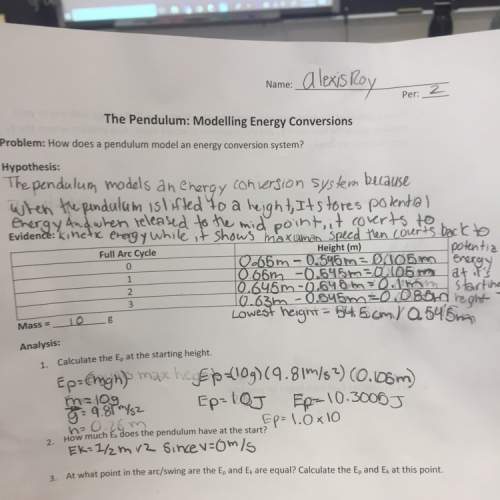
Two identical conducting spheres, fixed in place, attract each other with an electrostatic force of 0.7120 n when their center-to-center separation is 50 cm. the spheres e then connected by a thin conducting wire. when the wire is removed, the spheres repel each other with an electrostatic force of 0.1165 n. what were the initial charges on the spheres? since one is negative and you cannot tell whlch is positive or negative, there are two solutions. take the absolute value of the charges and enter the smaller value here. 9.77-10a-120 bemi a incorrect. thes 2/10 ersevious tries submn answer enter the larger value here. 6.60 x 10-6 c ou are correct.

Answers: 3
Another question on Physics

Physics, 21.06.2019 17:10
Space-time metric ds2= -dt2+at2dx2+bt2dy2+ct2dz2 (a)how does the area of a rectangle with vertices at ( x=0, y=0, z=0 ), (1,0,0 ), ( 0,1,0 ) and (1,1,0 ) changes with time? (b) if a photon moving in the x direction starts from the origin at t=1, when does it reach x=l? (ds=0 for the trajectory of a photon.) (c) the proper time for a particle is defined by cd=ds. what is the proper time for a particle to move along the trajectory ( x(t)=t, y(t)=0, z(t)=0 ) from t=0 to 1 ? what is the condition on the parameter a so that the velocity of the particle never exceeds the speed of light ?
Answers: 2

Physics, 22.06.2019 00:20
In the derivation of rrkm theory, a factor of 1/2 is introduced when equalizing the rates of formation and decomposition of activated complex as keal-hr) = ko this is clearly against the assumption of transition state theory that states all the activated complex in the transition state iss going to the product. find the reason why this factor is introduced here.
Answers: 2

Physics, 22.06.2019 02:30
The particle in a two-dimensional well is a useful model for the motion of electrons around the indole ring (3), the conjugated cycle found in the side chain of tryptophan. we may regard indole as a rectangle with sides of length 280 pm and 450 pm, with 10 electrons in the conjugated p system. as in case study 9.1, we assume that in the ground state of the molecule each quantized level is occupied by two electrons. (a) calculate the energy of an electron in the highest occupied level. (b) calculate the frequency of radiation that can induce a transition between the highest occupied and lowest unoccupied levels. 9.27 electrons around the porphine ring (4), the conjugated macrocycle that forms the structural basis of the heme group and the chlorophylls. we may treat the group as a circular ring of radius 440 pm, with 20 electrons in the conjugated system moving along the perimeter of the ring. as in exercise 9.26, assume that in the ground state of the molecule quantized each level is occupied by two electrons. (a) calculate the energy and angular momentum of an electron in the highest occupied level. (b) calculate the frequency of radiation that can induce a transition between the highest occupied and lowest unoccupied levels.
Answers: 1

Physics, 22.06.2019 14:30
What distance does a car travel as its speed changes from 0 to 20 m/s in 17 s at constant acceleration?
Answers: 1
You know the right answer?
Two identical conducting spheres, fixed in place, attract each other with an electrostatic force of...
Questions

History, 20.07.2019 01:30




Chemistry, 20.07.2019 01:30

English, 20.07.2019 01:30


History, 20.07.2019 01:30




Chemistry, 20.07.2019 01:30

Geography, 20.07.2019 01:30


Mathematics, 20.07.2019 01:30

Biology, 20.07.2019 01:30

Biology, 20.07.2019 01:30

Mathematics, 20.07.2019 01:30

History, 20.07.2019 01:30




